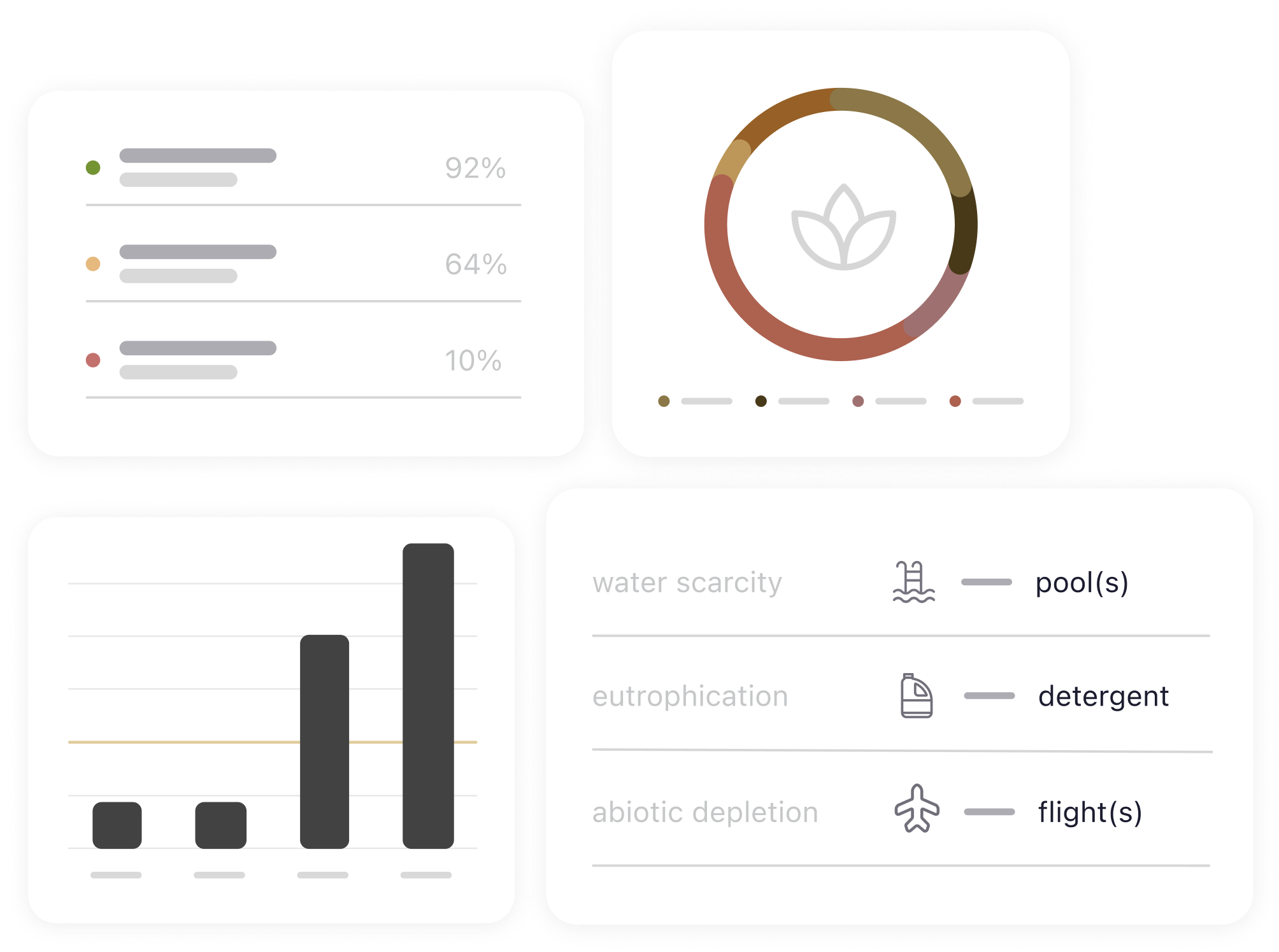Climate Change is one of the greatest threats to our planet and the fashion industry is a major contributor to greenhouse gas emissions. With an estimated 10% of global carbon emissions, it’s imperative that companies in the textile sector take robust and representative measures to reduce their environmental impact.
Setting science-based targets in fashion is no longer a choice, it’s a necessity. With the fashion industry accounting for 10% of global carbon emissions and 20% of global water waste, it’s clear that urgent action is needed
La Rhea Pepper, Managing Director of Textile Exchange
At BCome, the Platform for Global Sustainability Management in the fashion industry, we believe that the adoption of specific and quantifiable goals supported by a reliable methodology, allows for more effective strategic planning and greater efficiency in achieving reduction of environmental impact. In this article, we’ll explore how our technology can help your business align with science-based targets for a positive impact on the environment.
What you need to know about science-based targets
Science-based targets (SBT) are a set of goals defined by a company to establish a clear path to reduce its greenhouse gas emissions. An emissions reduction target is considered to have a scientific basis when it’s in line with the scale of reductions necessary to keep global warming below 1.5ºC with respect to pre-industrial levels, in accordance with the Paris Agreement.
However, SBTs aren’t limited exclusively to reducing carbon emissions. While most of these goals focus on reducing greenhouse gas emissions, they can also address other key areas of environmental impact, such as sustainable water management or efficient use of natural resources. They are often holistic and cover multiple aspects of sustainability, as they are designed to ensure that companies adopt more sustainable practices that reduce their environmental and social impact.
Why are science-based targets important in the fashion industry?
To set SBTs, textile companies must assess their emissions across the entire value chain, from the extraction of raw materials to the production and transportation of finished items.
Therefore, the relevance of science-based targets lies in their ability to provide a clear framework for companies to measure and reduce their environmental impact throughout their entire supply chain. By setting these goals, fashion companies can align their sustainability efforts with their overall goals and ensure that their actions work towards a sustainable future.
Science-based targets represent the best possible level of ambition and rigor for corporate sustainability. They provide a clear pathway for companies to take the necessary actions to transition to a low-carbon economy and reduce their environmental impacts, while also delivering long-term value to their stakeholders
Lila Karbassi, Chief of Programmes at the United Nations Global Compact
How can you lean on BCome to align with the SBTs?
At BCome, we provide companies with the tools and knowledge they need to assess and manage their environmental impact throughout their entire value chain. Our platform is designed to help companies in the fashion industry map and assess key environmental indicators such as water scarcity, global warming, eutrophication and abiotic depletion.
Using our technology, textile companies can gain a comprehensive understanding of their environmental performance and identify areas for improvement. Our end-to-end solution allows precise monitoring of environmental impact throughout the entire value chain, from the extraction of raw materials to the delivery of finished products to the warehouse.
Through the analysis of this data, companies have the ability to identify which are the stages of their chain in which they can achieve the most significant reductions and, in this way, establish goals that are consistent with sustainable growth.
Take action: discover how to establish science-based targets in your fashion business
Setting SBTs means that a fashion company takes steps to ensure that its goals are supported by the latest scientific research and aligned with the global objective of limiting Climate Change. This implies taking into account the most up-to-date information on the company’s impact to define specific targets that contribute to reducing its environmental footprint. These are the steps you must follow to establish science-based targets in your fashion business:
- Define your scope. The first step is to set the scope of your goals. This can include the environmental impact of your own operations, as well as that of your suppliers, transportation, and even the use of your products.
At BCome we can help you carry out complete traceability of your supply chain, from the extraction of raw materials to the delivery of the finished product. Our Sustainability Coaches will guide you in collecting this information so that you can have a better understanding of the journey your items experience and the suppliers behind them.
- Conduct an impact assessment as a benchmark. Once you’ve defined your scope, you need to assess your current impact levels to establish a baseline. This will help you understand the magnitude you need to reduce to achieve the science-based targets.
With the information collected during the traceability phase, at BCome we’re able to execute Life Cycle Assessments of all your products. In just 7 days after completing traceability, you will have the environmental impact assessment of your entire collection available on the platform based on four indicators: water scarcity, global warming, eutrophication and abiotic depletion.
- Trust a methodology. There are several methodologies available for establishing science-based targets, including the SBTi initiative and the Intergovernmental Panel on Climate Change (IPCC) guidelines. After the impact assessment, choose the methodology that best suits the needs and goals of your company.
- Set your targets. Taking into account your baseline evaluation and the chosen methodology, establish your objectives to reduce your impact. These targets must be aligned with the latest climate science and the global goal of limiting the temperature increase to 1.5°C.
In the case of Ecoalf, the brand that has trusted BCome to carry out Life Cycle Assessments of its products since our beginnings, has declared in its latest sustainability report that it seeks to become a carbon neutral company by 2030. For which it has set the targets of reducing its direct emissions by 20% by 2024 and 35% of emissions from e-commerce by 2023.
- Develop an action plan. Once you’ve established your goals, develop an action plan that specifies how they will be achieved. This may include a combination of several measures.
Returning to the goal established by Ecoalf, the company points out that its strategy to achieve this involves the ecodesign of its garments, seeking to minimize its environmental impact from the design phase to the end of the product’s life; the selection of materials based on their lower environmental impact; the choice of the most efficient production processes; working with suppliers whose compliance with environmental standards has been verified and minimizing the use of packaging to mitigate its environmental impact.
- Monitor and communicate progress. It’s important to monitor and report on your progress regularly to ensure that you are on track to achieve your goals. This will also help you identify areas where you need to adjust your strategy to achieve your targets.
Getting customized reports that are tailored to your specific needs will allow you to regularly assess progress towards established goals. At BCome, we offer you ad-hoc reports with critical information to understand the current status of your targets that allow you to identify the necessary adjustments to achieve your goals effectively.
The fashion industry plays an important role in the fight against Climate Change. By adopting science-based targets, textile companies can make a significant contribution to reducing their environmental footprint.
At BCome, we’re committed to helping companies adopt quantifiable goals that allow them to contribute to minimizing impact. To do this, we provide them with the tools and knowledge to assess and manage their impact. Our solutions allow the fashion industry to map, measure and evaluate key environmental indicators, identifying areas for improvement on which to focus efforts.
If your business seeks to have a positive impact on the environment and align with global sustainability goals, BCome can help you achieve it. Check today how our technology can help your business beat Climate Change. Let’s progress together towards a more sustainable future for the industry and our planet.









